| Reviews & Columns |
|
Reviews DVD TV on DVD Blu-ray 4K UHD International DVDs In Theaters Reviews by Studio Video Games Features Collector Series DVDs Easter Egg Database Interviews DVD Talk Radio Feature Articles Columns Anime Talk DVD Savant Horror DVDs The M.O.D. Squad Art House HD Talk Silent DVD
|
DVD Talk Forum |
|
|
| Resources |
|
DVD Price Search Customer Service #'s RCE Info Links |
|
Columns
|
|
|
Blind Dead Collection, The
Blue Underground // Unrated // September 27, 2005
List Price: $99.95 [Buy now and save at Amazon]
The four Blind Dead films that Spanish filmmaker Amando de Ossorio wrote and directed in the first half of the 1970s haven't been treated particularly well on DVD until now. Heavily-trimmed, awkwardly-titled cuts have been a mainstay in the gray market, and even the legitimate releases were butchered and have often been long out-of-print. Blue Underground has assembled a five disc collection of these movies -- Tombs of the Blind Dead, The Return of the Evil Dead, The Ghost Galleon, and Night of the Seagulls -- not only offering them uncut, but even tacking on new transfers of the edited, Americanized versions with which fans of the series have long been familiar.
Although there are four movies in the Blind Dead series, the films themselves are self-contained; the only recurring characters are the Knights Templar themselves, and even then, their origins and motivations vary from film to film. There are a couple of constants, though: the knights are portrayed as Satan worshippers who practiced ritual sacrifice in the quest for eternal life, and when eventually punished for their unspeakable acts, the eyes of the Templars are gruesomely removed. Centuries later, the mummified knights continue to return from the grave to offer their sacrifices, and still robbed of their sight, they rely on sound to hunt their prey.
Tombs of the Blind Dead
Summary: Former roommates -- and, as a flashback reveals,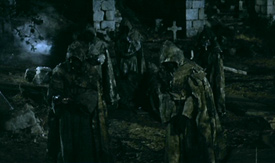 awkward lovers -- Betty and Virginia unexpectedly bump into one another again. Virginia introduces Bet to her friend Roger, and the ensuing love triangle boils over during a train ride, compelling Virginia to leap off the slow-moving locomotive and spend the night in the abandoned village of Berzano. This being a movie titled "Tombs of the Blind Dead" and all, I'll leave it up to you to guess what happens next. After a morning of ominous inquiries, Roger and Bet set out to find their friend, stumbling upon a police investigation at the ruins. After learning of her murder, Roger and Bet enlist the help of a local smuggler and his moll, and the four of them find the grisly answers to their questions among the tombs of the blind dead.
awkward lovers -- Betty and Virginia unexpectedly bump into one another again. Virginia introduces Bet to her friend Roger, and the ensuing love triangle boils over during a train ride, compelling Virginia to leap off the slow-moving locomotive and spend the night in the abandoned village of Berzano. This being a movie titled "Tombs of the Blind Dead" and all, I'll leave it up to you to guess what happens next. After a morning of ominous inquiries, Roger and Bet set out to find their friend, stumbling upon a police investigation at the ruins. After learning of her murder, Roger and Bet enlist the help of a local smuggler and his moll, and the four of them find the grisly answers to their questions among the tombs of the blind dead.
Review: The atmospheric Tombs of the Blind Dead reminded me of another Spanish zombie film, Let Sleeping Corpses Lie, in some respects. Both movies place a large part of their emphasis on a couple's investigation of a murder; its characters aren't continually pursued by the undead for the entire length of the movie, and the Knights Templar aren't the sort of cinematic creatures who lurch on-screen like clockwork every eight minutes. That restraint makes the scenes where the Templars do appear far more effective than they would've been otherwise, and although the Templars are only in a handful of scenes, when they are on-screen, they usually linger for quite a long time. The knights don't jump out of the shadows -- they slowly envelop their prey, and the combination of their slow stalking and the beautiful photography builds several extremely tense setpieces.
Although Tombs of the Blind Dead isn't a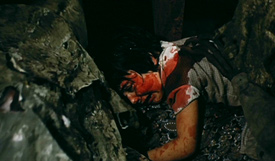 particularly gory film, several of its sequences are deeply unsettling, particularly a prolonged torture flashback and a brutal rape. The skeletal look of the Templars with their long, rake-like fingers and dusty, tattered cloaks remains unique, and there's something almost hypnotic about the use of slow-motion when the knights are on horseback. Horror movies often make more effective use of sound than any other genre, and in a film where its blood-starved villains are reliant on aural cues to locate their victims, it's the lack of sound that contributes so greatly to the sense of dread. Although the storytelling has its shares of flaws, lazily tossing in scores of plot contrivances and inconsistencies purely for dramatic effect, the simplicity of the story works to its benefit. Ignoring the still frames that close out the movie, the dark, nihilistic ending is fantastic. Very highly recommended.
particularly gory film, several of its sequences are deeply unsettling, particularly a prolonged torture flashback and a brutal rape. The skeletal look of the Templars with their long, rake-like fingers and dusty, tattered cloaks remains unique, and there's something almost hypnotic about the use of slow-motion when the knights are on horseback. Horror movies often make more effective use of sound than any other genre, and in a film where its blood-starved villains are reliant on aural cues to locate their victims, it's the lack of sound that contributes so greatly to the sense of dread. Although the storytelling has its shares of flaws, lazily tossing in scores of plot contrivances and inconsistencies purely for dramatic effect, the simplicity of the story works to its benefit. Ignoring the still frames that close out the movie, the dark, nihilistic ending is fantastic. Very highly recommended.
This DVD includes two versions of Tombs of the Blind Dead -- the uncut La Noche del Terror Ciego and an eviscerated English version. There's a fourteen minute difference between the two, with nearly every trace of blood, gore, and sexuality trimmed out of the American cut.
Video: Both cuts of Tombs of the Blind Dead are in anamorphic widescreen and pillarboxed to an aspect ratio of 1.66:1. The title sequence for the English version is further pillarboxed to 1.37:1, and its title card simply reads The Blind Dead rather than the longer, more familiar name. The English version is grainier and not as well-defined as its Spanish counterpart, and its palette doesn't look nearly as natural. Aside from some occasional and very light ringing, one oddity about the Spanish version is that the image gets somewhat blurry during pans and quick motion.
Audio: Both the Spanish and English cuts of the movie are presented in Dolby Digital mono. (The Spanish version doesn't include an English track or vice versa.) The Spanish audio sounds decent enough -- bass response is fairly lightweight, but its dialogue comes through as cleanly and clearly as can reasonably be expected. The Spanish version of the film also offers optional English subtitles, and neither cut is closed captioned.
Extras: Several extras are available under the submenu for the English cut of the film, including an anamorphic widescreen trailer and an extensive still gallery. Far more interesting is an alternate opening sequence under the title Revenge of the Planet Ape. To cash in on the success of Planet of the Apes, a distributor tacked on a voiceover about how mankind rose up against their superintelligent simian overlords, blinding them as their leader vowed to seek revenge from the grave. Fascinatingly, nothing else from the already-heavily-censored movie was changed; no new footage was even shot for this minute and a half prologue.
The Return of the Evil Dead
Summary: Although Lone Fleming returns for the sequel, it's in a completely different role. Not only do none of the characters from Tombs of the Blind Dead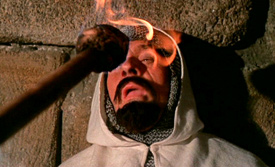 make a second appearance, the backstory of the Knights Templar and the way Berzano is presented are both dramatically different. The story this time goes that the villagers torched the eyes of the then-human Templar knights so that even if they were to return from the dead, they wouldn't be able to find their way back to the village. No, they may not be able to see, but after being revived by the village idiot centuries later, the fireworks used to commemorate the Burning Festival guides them back to Berzano. They butcher virtually everyone in the town, but a handful of them escape to a nearby church, and their internal squabbling proves to be as much of a threat as the blind dead that await them outside.
make a second appearance, the backstory of the Knights Templar and the way Berzano is presented are both dramatically different. The story this time goes that the villagers torched the eyes of the then-human Templar knights so that even if they were to return from the dead, they wouldn't be able to find their way back to the village. No, they may not be able to see, but after being revived by the village idiot centuries later, the fireworks used to commemorate the Burning Festival guides them back to Berzano. They butcher virtually everyone in the town, but a handful of them escape to a nearby church, and their internal squabbling proves to be as much of a threat as the blind dead that await them outside.
Review: Sitting through The Return of the Evil Dead is like wading through one of the later Jaws sequels; yes, the body count is exponentially higher, the Knights Templar are in virtually every scene, there's an attempt to keep the pacing amped up...and in the process, pretty much everything worthwhile about the original is discarded. The Templars in Tombs of the Blind Dead were hunters, and the actual kill wasn't what added to that pervasive sense of dread...it was the hunt...the stalking. The sequel doesn't bother with this at all. Many of the deaths are largely off-screen -- someone will take a sword to the face, or a blade will plunge into an unconvincing mock-chest. Fast and unexpected can be effective, and so can slow and tensely anticipated. But just sword swipe after sword swipe after sword swipe...? Not really, no, and the movie doesn't improve when the survivors of the assault on the village barricade themselves in a church.
The Return of the Evil Dead seems like a deliberate attempt to copy Night of the Living Dead, again missing the point of why that film is as effective as it is. Night of the Living Dead has two things in particular going for it, the first being the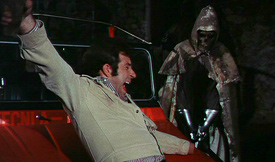 conflicts of the characters grudgingly holed up in the farmhouse. Not that Tombs of the Blind Dead was rife with deep characterization, but at least I knew who the characters were and how they related to one another. Return... has a much larger cast and does little to distinguish some of them. I could tell that hardly anyone could tolerate anyone else, but I never had a firm grasp on why, exactly, and there were several times where I'd confuse who was who. Their motivation for doing the illogical things they do is even more baffling. The other distinguishing factor of Night of the Living Dead -- perhaps even the primary reason it's as tense a film as it is -- is that that it was just a matter of time until the zombies stormed the house. Once everyone piles into the church, the threat of the Templars is largely gone. Yes, they have the church surrounded, but they don't do anything. There are worse plans than gradually picking off everyone as they try to escape, but from a dramatic standpoint, it's not nearly as interesting to watch.
conflicts of the characters grudgingly holed up in the farmhouse. Not that Tombs of the Blind Dead was rife with deep characterization, but at least I knew who the characters were and how they related to one another. Return... has a much larger cast and does little to distinguish some of them. I could tell that hardly anyone could tolerate anyone else, but I never had a firm grasp on why, exactly, and there were several times where I'd confuse who was who. Their motivation for doing the illogical things they do is even more baffling. The other distinguishing factor of Night of the Living Dead -- perhaps even the primary reason it's as tense a film as it is -- is that that it was just a matter of time until the zombies stormed the house. Once everyone piles into the church, the threat of the Templars is largely gone. Yes, they have the church surrounded, but they don't do anything. There are worse plans than gradually picking off everyone as they try to escape, but from a dramatic standpoint, it's not nearly as interesting to watch.
All of this culminates in a disappointing, anticlimatic cheat of an ending. The Return of the Evil Dead isn't agonizingly, unwatchably bad, but it pales in comparison to Tombs of the Blind Dead, and if it weren't part of this box set, it's not a movie I'd buy on its own.
The difference in runtime between the English and Spanish cuts is much slimmer this time -- closer to four minutes in total, and some blood and nudity do sneak in.
Video: Again, both versions of the movie are presented in 1.66:1 anamorphic widescreen, although it's the English version that's less grainy this time around. Color saturation varies drastically between the two; The Return of the Evil Dead has a brighter, warmer palette, while El Ataque de los Muertos Sin Ojos is cold and extremely dark (I couldn't even tell that the Templars were partially transparent in the Spanish version's train station attack).
The Spanish cut also looks to suffer from some type of convergence problem -- look at the greens in the cropped screenshot below from El Ataque de los Muertos sin Ojos, one example of a flaw that's visible throughout: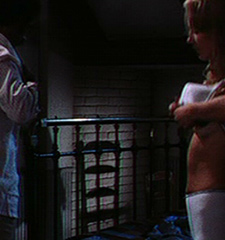 There's some horrible vertical jitter during an early escape on horseback, although its presence in both versions of the film seems to suggest that it might not be a problem specific to these transfers. It's a disappointment that better elements weren't available for the Spanish version, but it's more than watchable and still almost certainly the best this film has ever looked on home video.
There's some horrible vertical jitter during an early escape on horseback, although its presence in both versions of the film seems to suggest that it might not be a problem specific to these transfers. It's a disappointment that better elements weren't available for the Spanish version, but it's more than watchable and still almost certainly the best this film has ever looked on home video.
Audio: The monaural Spanish audio is pretty poor -- the track is shrill and heavily distorted, chapter 9 opens with a loud pop, and there's a pervasive buzz in the background throughout the entire movie. Although I still opted for the uncut Spanish version of the film, the mono track for the English cut sounds considerably better. Again, each version of the movie has one and only one soundtrack, and although the Spanish cut has optional English subtitles, there are no other subs or closed captions.
Extras: An anamorphic widescreen trailer and a still gallery with dozens and dozens of shots of photos and artwork.
The Ghost Galleon
Summary: As part of a promotional stunt for a new speed boat, swimsuit model Kathy and her starlet co-star strand themselves in the middle of the ocean. After becoming enveloped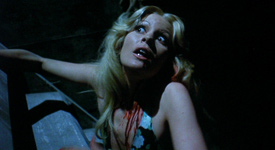 in a thick, impenetrable fog, they stumble onto a decrepit, extradimensional Spanish galleon carrying the caskets of the Knights Templar. Kathy's roommate catches wind of Howard Tucker's scheme and tags along as the sporting goods manufacturer, his flunky, a modeling agent, and a professor set out on a rescue mission. Since their scheme is a closely guarded secret, there's no one to rescue the rescuers when they find themselves trapped on a ship with the blind dead.
in a thick, impenetrable fog, they stumble onto a decrepit, extradimensional Spanish galleon carrying the caskets of the Knights Templar. Kathy's roommate catches wind of Howard Tucker's scheme and tags along as the sporting goods manufacturer, his flunky, a modeling agent, and a professor set out on a rescue mission. Since their scheme is a closely guarded secret, there's no one to rescue the rescuers when they find themselves trapped on a ship with the blind dead.
Review: The Ghost Galleon gets points for an original plot, at least. As strange as that synopsis might sound, it could halfway-pass as a remake of Tombs of the Blind Dead, exchanging an abandoned village for a Spanish galleon. The core of the story is the same, revolving around a search for a friend whose bad call pitted her against a small army of murderous mummies, and there's a rape, a woman's shoe that gets caught in a wooden plank while escaping the Templars, an almost-lesbian-tinged flashback about girls rooming together at school, and a bleak finale that closes on a still shot.
There are a lot of surface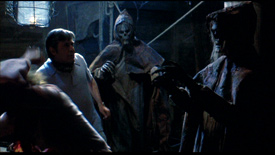 similarities, but The Ghost Galleon is quite a bit tamer than the Blind Dead movies before it. There's even less blood and gore -- the Templars only kill one person on-screen, although to their credit, they do dismember her and gnaw on her severed limbs -- and the sexuality is largely tossed out. There are three lengthy attacks by the knights, the first of which comes a little after half an hour in. None of them are nearly as tense as anything in Tombs..., and the in-between moments are even duller and more repetitive than this review. The Ghost Galleon is a very nicely shot film, and the sequences on the ship are a nice fit with Amando de Ossorio's taste for the eerie and atmospheric. The Templars themselves look great, although the miniature effects are ridiculous, looking almost as if the ship had been yanked out of a box of Fruity Pebbles and dropped in a bathtub. For the second time in a row, there's nothing linking this movie with any of the others in the series; the Templars don't even get their trademark sacrificial flashback, and the sightless aspect really doesn't come into play. The Ghost Galleon is still a drastic improvement over The Return of the Evil Dead, and deeply flawed though it may be, the movie holds some sort of bizarre, inexplicable charm. I really dig the ending too. Hesitantly recommended, although it's not much of a horror movie.
similarities, but The Ghost Galleon is quite a bit tamer than the Blind Dead movies before it. There's even less blood and gore -- the Templars only kill one person on-screen, although to their credit, they do dismember her and gnaw on her severed limbs -- and the sexuality is largely tossed out. There are three lengthy attacks by the knights, the first of which comes a little after half an hour in. None of them are nearly as tense as anything in Tombs..., and the in-between moments are even duller and more repetitive than this review. The Ghost Galleon is a very nicely shot film, and the sequences on the ship are a nice fit with Amando de Ossorio's taste for the eerie and atmospheric. The Templars themselves look great, although the miniature effects are ridiculous, looking almost as if the ship had been yanked out of a box of Fruity Pebbles and dropped in a bathtub. For the second time in a row, there's nothing linking this movie with any of the others in the series; the Templars don't even get their trademark sacrificial flashback, and the sightless aspect really doesn't come into play. The Ghost Galleon is still a drastic improvement over The Return of the Evil Dead, and deeply flawed though it may be, the movie holds some sort of bizarre, inexplicable charm. I really dig the ending too. Hesitantly recommended, although it's not much of a horror movie.
A 106 minute cut of The Ghost Galleon has long been rumored, but none of that footage, if it ever existed to begin with, has ever surfaced. Because the film made it across the pond in one piece, there aren't separate versions as there were for the previous two movies in this collection.
Video: The 1.85:1 anamorphic widescreen video starts off looking a little soft and bland, but the sequences on the galleon -- nearly the entire movie, in other words -- come dangerously close to perfection, sporting nicely tinted colors, robust black levels, and a fairly impressive level of detail and clarity. There's no visible wear or speckling.
Audio: The Ghost Galleon features monaural soundtracks in English and Spanish. They both sound pretty good -- the Spanish track has a bit of light noise lurking in the background, and the English dialogue sounds harsher and doesn't match the characters particularly well. English subtitles are offered, and the disc is not closed captioned.
Extras: Along with the ubiquitous still gallery, there are two anamorphic widescreen trailers, one of which sports the Americanized Horror of the Zombies title. Two radio spots and a TV ad are also included under the Horror... title.
Night of the Seagulls
Summary: Dr. Henry Stein has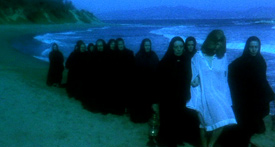 been dispatched to a small seaside village to serve as its doctor, but he and his wife Joan meet with a surprisingly chilly reception upon their arrival. The current doctor is desperately trying to flee and attempts to convince Henry to do the same. Henry's determined to stay, ignoring his predecessor's advice to stay indoors at night and ignore the villagers' strange behavior. He and his wife eventually discover the townspeople's centuries-old secret -- every seven years, seven young women are sacrificed to the Knights Templar to ensure the safety of their village. Henry interrupts one of these sacrifices and finds himself and his companions at the mercy of the blind dead.
been dispatched to a small seaside village to serve as its doctor, but he and his wife Joan meet with a surprisingly chilly reception upon their arrival. The current doctor is desperately trying to flee and attempts to convince Henry to do the same. Henry's determined to stay, ignoring his predecessor's advice to stay indoors at night and ignore the villagers' strange behavior. He and his wife eventually discover the townspeople's centuries-old secret -- every seven years, seven young women are sacrificed to the Knights Templar to ensure the safety of their village. Henry interrupts one of these sacrifices and finds himself and his companions at the mercy of the blind dead.
Review: All of the Blind Dead films move at a slower, deliberate pace, but Night of the Seagulls (or The Night of the Sea Gulls, as the title card reads) is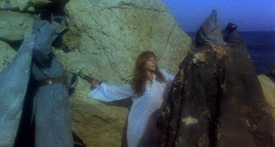 the only one in the series I found to be outright boring. The villagers are the villains for most of the movie rather than the Templars, but they're better described as impolite than evil. Sure, they do drag young girls to their doom, and they don't treat the mentally disabled with kid gloves (although I'd throw rocks at someone who continually referred to himself in the third person too), but that's awfully tame in something passing itself off as a horror movie. The undead knights aren't given much of anything to do for the bulk of the movie. The ritualistic sacrifices are repetitive (as ritualistic things tend to be, by definition), and it's only in the last twenty minutes of the movie that they get around to attacking a moving target. Even then, it's the same barricading, torch waving, and undead horse theft seen throughout the series. There's nothing new or original to be found in this fourth and final installment, and the pacing of the movie is typified in its fascination with crabs that slooooooooooooowly surround the corpses of the young girls for no apparent reason or purpose other than to remind the viewer that the movie's set near the sea. By far the worst of the four movies, Night of the Seagulls ends the Blind Dead series on a sour note.
the only one in the series I found to be outright boring. The villagers are the villains for most of the movie rather than the Templars, but they're better described as impolite than evil. Sure, they do drag young girls to their doom, and they don't treat the mentally disabled with kid gloves (although I'd throw rocks at someone who continually referred to himself in the third person too), but that's awfully tame in something passing itself off as a horror movie. The undead knights aren't given much of anything to do for the bulk of the movie. The ritualistic sacrifices are repetitive (as ritualistic things tend to be, by definition), and it's only in the last twenty minutes of the movie that they get around to attacking a moving target. Even then, it's the same barricading, torch waving, and undead horse theft seen throughout the series. There's nothing new or original to be found in this fourth and final installment, and the pacing of the movie is typified in its fascination with crabs that slooooooooooooowly surround the corpses of the young girls for no apparent reason or purpose other than to remind the viewer that the movie's set near the sea. By far the worst of the four movies, Night of the Seagulls ends the Blind Dead series on a sour note.
Video: The exterior shots in Night of the Seagulls are so soft and grainy that they look like they were shot through gauze, although the interiors in this 1.85:1 anamorphic widescreen presentation are generally sharper and better defined. Colors tend to be lifeless throughout. This all could be a factor of the original photography, but this is visually the weakest of the four Blind Dead films.
Audio: Another pair of utilitarian Dolby Digital mono tracks, again in English and Spanish. No closed captions, although English subtitles play with the film when the Spanish track is selected.
Extras: An anamorphic widescreen trailer and a still gallery.
The Bonus Disc
The bonus disc in this collection includes a pair of featurettes, although their emphasis is on the man behind the Blind Dead series rather than the films themselves. The first is the 25 minute "The Last Templar", a retrospective presumably shot for Spanish television. It's a compilation of interviews with Ossario and various other personalities, and clips from several different films are inserted where necessary. "The Last Templar" begins by detailing Ossario's break into the Spanish entertainment industry, covering the progression of his career from the experimental and largely unseen La bandera negra to attempts working in other genres before settling into horror. A fair amount of time is understandably spent on the Blind Dead series as a whole, although it doesn't delve in-depth into the individual films to any great extent. The interviews also give a sense of how frustrating it must have been to work in the Spanish film industry, never having the benefit of much time or money, and even an established and successful director like Ossario saw his fortunes dwindle and numerous scripts go unproduced.
There's also a ten minute interview with the director titled "Unearthing the Blind Dead", which is prefaced by a disclaimer about the poor sound quality. Since the interview is in Spanish and is helpfully subtitled, that's really not a concern. He discusses the course of his career, the economics of having to shoot a movie in 4 weeks, each of the Blind Dead movies (going into the most detail for The Ghost Galleon), and briefly commenting on the unproduced fifth film in the series.
"Amando de Ossorio: Farewell to Spain's Knight of Horror", a four-page retrospective written by Mike Hodges for Shivers shortly after the director's death, is included on the DVD-ROM portion of the disc.
The Packaging
The Blind Dead collection comes packaged in a sturdy cardboard coffin-shaped box whose face opens to reveal five keepcases. The four movies are packaged in transparent, standard-size cases (with gorgeous painted cover art), and the bonus disc comes in a slimline case. The coffin is incrementally taller than a keepcase, and although its height allows it to fit on most DVD shelves, its shape and width leave it better suited elsewhere. Because these five DVDs do come in keepcases, they can obviously be taken out of the coffin and placed on a rack like any other DVD, but the box looks great and deserves to be displayed.
comes packaged in a sturdy cardboard coffin-shaped box whose face opens to reveal five keepcases. The four movies are packaged in transparent, standard-size cases (with gorgeous painted cover art), and the bonus disc comes in a slimline case. The coffin is incrementally taller than a keepcase, and although its height allows it to fit on most DVD shelves, its shape and width leave it better suited elsewhere. Because these five DVDs do come in keepcases, they can obviously be taken out of the coffin and placed on a rack like any other DVD, but the box looks great and deserves to be displayed.
Along with the five discs, Nigel J. Burrell's Knights of Terror -- a fairly lengthy examination of the Blind Dead movies and the story of the Knights Templar -- can also be found inside the coffin-shaped box. A large number of black and white stills are interspersed throughout the forty-page booklet along with Burrell's detailed synopses and reviews.
Conclusion
Most online stores seem to be carrying this set for close to $70, and for a nicely packaged box set of four movies, that's not at all unreasonable. The problem, at least for me, is that it's these four movies. I fall somewhere between liking and merely tolerating The Return of the Evil Dead and The Ghost Galleon, and Night of the Seagulls is a half-hearted rehash of more of the same. As great as Tombs of the Blind Dead is, it alone isn't worth the price of admission. Fans familiar with these movies probably already have their pre-orders in place, and I'm sure they'll be thrilled with the quality of these DVDs, even if the extras are understandably sparse. Those who haven't caught any of the Blind Dead films before may want to be more cautious. The packaging, booklet, and bonus disc are all nice, but they're not indispensable, and readers with more of a casual interest may want to hold off for the inevitable release of a separate Tombs of the Blind Dead DVD.
Other Notes: I typically think of Blue Underground as being a region-free shop, but I guess licensing issues prevented them from doing that with this collection. The four movies are coded for region 1, although the bonus disc is still region-free. I hate using star ratings, but in particular, ignore the rating in the sidebar for video quality if you've seen these movies before; these DVDs are widely considered to be a five-star effort compared to every other home video release.
Although there are four movies in the Blind Dead series, the films themselves are self-contained; the only recurring characters are the Knights Templar themselves, and even then, their origins and motivations vary from film to film. There are a couple of constants, though: the knights are portrayed as Satan worshippers who practiced ritual sacrifice in the quest for eternal life, and when eventually punished for their unspeakable acts, the eyes of the Templars are gruesomely removed. Centuries later, the mummified knights continue to return from the grave to offer their sacrifices, and still robbed of their sight, they rely on sound to hunt their prey.
Tombs of the Blind Dead
Summary: Former roommates -- and, as a flashback reveals,
 awkward lovers -- Betty and Virginia unexpectedly bump into one another again. Virginia introduces Bet to her friend Roger, and the ensuing love triangle boils over during a train ride, compelling Virginia to leap off the slow-moving locomotive and spend the night in the abandoned village of Berzano. This being a movie titled "Tombs of the Blind Dead" and all, I'll leave it up to you to guess what happens next. After a morning of ominous inquiries, Roger and Bet set out to find their friend, stumbling upon a police investigation at the ruins. After learning of her murder, Roger and Bet enlist the help of a local smuggler and his moll, and the four of them find the grisly answers to their questions among the tombs of the blind dead.
awkward lovers -- Betty and Virginia unexpectedly bump into one another again. Virginia introduces Bet to her friend Roger, and the ensuing love triangle boils over during a train ride, compelling Virginia to leap off the slow-moving locomotive and spend the night in the abandoned village of Berzano. This being a movie titled "Tombs of the Blind Dead" and all, I'll leave it up to you to guess what happens next. After a morning of ominous inquiries, Roger and Bet set out to find their friend, stumbling upon a police investigation at the ruins. After learning of her murder, Roger and Bet enlist the help of a local smuggler and his moll, and the four of them find the grisly answers to their questions among the tombs of the blind dead. Review: The atmospheric Tombs of the Blind Dead reminded me of another Spanish zombie film, Let Sleeping Corpses Lie, in some respects. Both movies place a large part of their emphasis on a couple's investigation of a murder; its characters aren't continually pursued by the undead for the entire length of the movie, and the Knights Templar aren't the sort of cinematic creatures who lurch on-screen like clockwork every eight minutes. That restraint makes the scenes where the Templars do appear far more effective than they would've been otherwise, and although the Templars are only in a handful of scenes, when they are on-screen, they usually linger for quite a long time. The knights don't jump out of the shadows -- they slowly envelop their prey, and the combination of their slow stalking and the beautiful photography builds several extremely tense setpieces.
Although Tombs of the Blind Dead isn't a
 particularly gory film, several of its sequences are deeply unsettling, particularly a prolonged torture flashback and a brutal rape. The skeletal look of the Templars with their long, rake-like fingers and dusty, tattered cloaks remains unique, and there's something almost hypnotic about the use of slow-motion when the knights are on horseback. Horror movies often make more effective use of sound than any other genre, and in a film where its blood-starved villains are reliant on aural cues to locate their victims, it's the lack of sound that contributes so greatly to the sense of dread. Although the storytelling has its shares of flaws, lazily tossing in scores of plot contrivances and inconsistencies purely for dramatic effect, the simplicity of the story works to its benefit. Ignoring the still frames that close out the movie, the dark, nihilistic ending is fantastic. Very highly recommended.
particularly gory film, several of its sequences are deeply unsettling, particularly a prolonged torture flashback and a brutal rape. The skeletal look of the Templars with their long, rake-like fingers and dusty, tattered cloaks remains unique, and there's something almost hypnotic about the use of slow-motion when the knights are on horseback. Horror movies often make more effective use of sound than any other genre, and in a film where its blood-starved villains are reliant on aural cues to locate their victims, it's the lack of sound that contributes so greatly to the sense of dread. Although the storytelling has its shares of flaws, lazily tossing in scores of plot contrivances and inconsistencies purely for dramatic effect, the simplicity of the story works to its benefit. Ignoring the still frames that close out the movie, the dark, nihilistic ending is fantastic. Very highly recommended. This DVD includes two versions of Tombs of the Blind Dead -- the uncut La Noche del Terror Ciego and an eviscerated English version. There's a fourteen minute difference between the two, with nearly every trace of blood, gore, and sexuality trimmed out of the American cut.
Video: Both cuts of Tombs of the Blind Dead are in anamorphic widescreen and pillarboxed to an aspect ratio of 1.66:1. The title sequence for the English version is further pillarboxed to 1.37:1, and its title card simply reads The Blind Dead rather than the longer, more familiar name. The English version is grainier and not as well-defined as its Spanish counterpart, and its palette doesn't look nearly as natural. Aside from some occasional and very light ringing, one oddity about the Spanish version is that the image gets somewhat blurry during pans and quick motion.
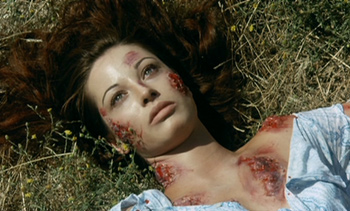 |
| La Noche del Terror Ciego |
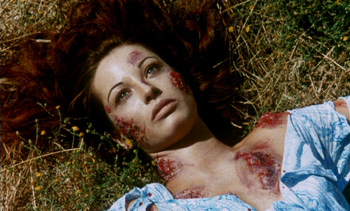 |
| Tombs of the Blind Dead |
Audio: Both the Spanish and English cuts of the movie are presented in Dolby Digital mono. (The Spanish version doesn't include an English track or vice versa.) The Spanish audio sounds decent enough -- bass response is fairly lightweight, but its dialogue comes through as cleanly and clearly as can reasonably be expected. The Spanish version of the film also offers optional English subtitles, and neither cut is closed captioned.
Extras: Several extras are available under the submenu for the English cut of the film, including an anamorphic widescreen trailer and an extensive still gallery. Far more interesting is an alternate opening sequence under the title Revenge of the Planet Ape. To cash in on the success of Planet of the Apes, a distributor tacked on a voiceover about how mankind rose up against their superintelligent simian overlords, blinding them as their leader vowed to seek revenge from the grave. Fascinatingly, nothing else from the already-heavily-censored movie was changed; no new footage was even shot for this minute and a half prologue.
The Return of the Evil Dead
Summary: Although Lone Fleming returns for the sequel, it's in a completely different role. Not only do none of the characters from Tombs of the Blind Dead
 make a second appearance, the backstory of the Knights Templar and the way Berzano is presented are both dramatically different. The story this time goes that the villagers torched the eyes of the then-human Templar knights so that even if they were to return from the dead, they wouldn't be able to find their way back to the village. No, they may not be able to see, but after being revived by the village idiot centuries later, the fireworks used to commemorate the Burning Festival guides them back to Berzano. They butcher virtually everyone in the town, but a handful of them escape to a nearby church, and their internal squabbling proves to be as much of a threat as the blind dead that await them outside.
make a second appearance, the backstory of the Knights Templar and the way Berzano is presented are both dramatically different. The story this time goes that the villagers torched the eyes of the then-human Templar knights so that even if they were to return from the dead, they wouldn't be able to find their way back to the village. No, they may not be able to see, but after being revived by the village idiot centuries later, the fireworks used to commemorate the Burning Festival guides them back to Berzano. They butcher virtually everyone in the town, but a handful of them escape to a nearby church, and their internal squabbling proves to be as much of a threat as the blind dead that await them outside. Review: Sitting through The Return of the Evil Dead is like wading through one of the later Jaws sequels; yes, the body count is exponentially higher, the Knights Templar are in virtually every scene, there's an attempt to keep the pacing amped up...and in the process, pretty much everything worthwhile about the original is discarded. The Templars in Tombs of the Blind Dead were hunters, and the actual kill wasn't what added to that pervasive sense of dread...it was the hunt...the stalking. The sequel doesn't bother with this at all. Many of the deaths are largely off-screen -- someone will take a sword to the face, or a blade will plunge into an unconvincing mock-chest. Fast and unexpected can be effective, and so can slow and tensely anticipated. But just sword swipe after sword swipe after sword swipe...? Not really, no, and the movie doesn't improve when the survivors of the assault on the village barricade themselves in a church.
The Return of the Evil Dead seems like a deliberate attempt to copy Night of the Living Dead, again missing the point of why that film is as effective as it is. Night of the Living Dead has two things in particular going for it, the first being the
 conflicts of the characters grudgingly holed up in the farmhouse. Not that Tombs of the Blind Dead was rife with deep characterization, but at least I knew who the characters were and how they related to one another. Return... has a much larger cast and does little to distinguish some of them. I could tell that hardly anyone could tolerate anyone else, but I never had a firm grasp on why, exactly, and there were several times where I'd confuse who was who. Their motivation for doing the illogical things they do is even more baffling. The other distinguishing factor of Night of the Living Dead -- perhaps even the primary reason it's as tense a film as it is -- is that that it was just a matter of time until the zombies stormed the house. Once everyone piles into the church, the threat of the Templars is largely gone. Yes, they have the church surrounded, but they don't do anything. There are worse plans than gradually picking off everyone as they try to escape, but from a dramatic standpoint, it's not nearly as interesting to watch.
conflicts of the characters grudgingly holed up in the farmhouse. Not that Tombs of the Blind Dead was rife with deep characterization, but at least I knew who the characters were and how they related to one another. Return... has a much larger cast and does little to distinguish some of them. I could tell that hardly anyone could tolerate anyone else, but I never had a firm grasp on why, exactly, and there were several times where I'd confuse who was who. Their motivation for doing the illogical things they do is even more baffling. The other distinguishing factor of Night of the Living Dead -- perhaps even the primary reason it's as tense a film as it is -- is that that it was just a matter of time until the zombies stormed the house. Once everyone piles into the church, the threat of the Templars is largely gone. Yes, they have the church surrounded, but they don't do anything. There are worse plans than gradually picking off everyone as they try to escape, but from a dramatic standpoint, it's not nearly as interesting to watch. All of this culminates in a disappointing, anticlimatic cheat of an ending. The Return of the Evil Dead isn't agonizingly, unwatchably bad, but it pales in comparison to Tombs of the Blind Dead, and if it weren't part of this box set, it's not a movie I'd buy on its own.
The difference in runtime between the English and Spanish cuts is much slimmer this time -- closer to four minutes in total, and some blood and nudity do sneak in.
Video: Again, both versions of the movie are presented in 1.66:1 anamorphic widescreen, although it's the English version that's less grainy this time around. Color saturation varies drastically between the two; The Return of the Evil Dead has a brighter, warmer palette, while El Ataque de los Muertos Sin Ojos is cold and extremely dark (I couldn't even tell that the Templars were partially transparent in the Spanish version's train station attack).
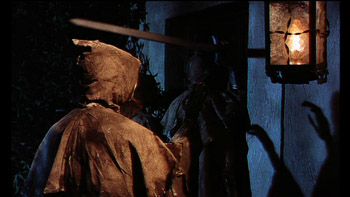 |
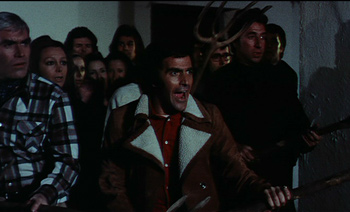 |
| El Ataque de los Muertos sin Ojos |
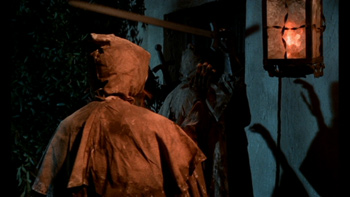 |
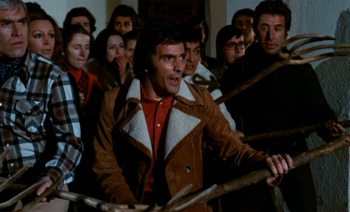 |
| The Return of the Evil Dead |
The Spanish cut also looks to suffer from some type of convergence problem -- look at the greens in the cropped screenshot below from El Ataque de los Muertos sin Ojos, one example of a flaw that's visible throughout:

Audio: The monaural Spanish audio is pretty poor -- the track is shrill and heavily distorted, chapter 9 opens with a loud pop, and there's a pervasive buzz in the background throughout the entire movie. Although I still opted for the uncut Spanish version of the film, the mono track for the English cut sounds considerably better. Again, each version of the movie has one and only one soundtrack, and although the Spanish cut has optional English subtitles, there are no other subs or closed captions.
Extras: An anamorphic widescreen trailer and a still gallery with dozens and dozens of shots of photos and artwork.
The Ghost Galleon
Summary: As part of a promotional stunt for a new speed boat, swimsuit model Kathy and her starlet co-star strand themselves in the middle of the ocean. After becoming enveloped
 in a thick, impenetrable fog, they stumble onto a decrepit, extradimensional Spanish galleon carrying the caskets of the Knights Templar. Kathy's roommate catches wind of Howard Tucker's scheme and tags along as the sporting goods manufacturer, his flunky, a modeling agent, and a professor set out on a rescue mission. Since their scheme is a closely guarded secret, there's no one to rescue the rescuers when they find themselves trapped on a ship with the blind dead.
in a thick, impenetrable fog, they stumble onto a decrepit, extradimensional Spanish galleon carrying the caskets of the Knights Templar. Kathy's roommate catches wind of Howard Tucker's scheme and tags along as the sporting goods manufacturer, his flunky, a modeling agent, and a professor set out on a rescue mission. Since their scheme is a closely guarded secret, there's no one to rescue the rescuers when they find themselves trapped on a ship with the blind dead. Review: The Ghost Galleon gets points for an original plot, at least. As strange as that synopsis might sound, it could halfway-pass as a remake of Tombs of the Blind Dead, exchanging an abandoned village for a Spanish galleon. The core of the story is the same, revolving around a search for a friend whose bad call pitted her against a small army of murderous mummies, and there's a rape, a woman's shoe that gets caught in a wooden plank while escaping the Templars, an almost-lesbian-tinged flashback about girls rooming together at school, and a bleak finale that closes on a still shot.
There are a lot of surface
 similarities, but The Ghost Galleon is quite a bit tamer than the Blind Dead movies before it. There's even less blood and gore -- the Templars only kill one person on-screen, although to their credit, they do dismember her and gnaw on her severed limbs -- and the sexuality is largely tossed out. There are three lengthy attacks by the knights, the first of which comes a little after half an hour in. None of them are nearly as tense as anything in Tombs..., and the in-between moments are even duller and more repetitive than this review. The Ghost Galleon is a very nicely shot film, and the sequences on the ship are a nice fit with Amando de Ossorio's taste for the eerie and atmospheric. The Templars themselves look great, although the miniature effects are ridiculous, looking almost as if the ship had been yanked out of a box of Fruity Pebbles and dropped in a bathtub. For the second time in a row, there's nothing linking this movie with any of the others in the series; the Templars don't even get their trademark sacrificial flashback, and the sightless aspect really doesn't come into play. The Ghost Galleon is still a drastic improvement over The Return of the Evil Dead, and deeply flawed though it may be, the movie holds some sort of bizarre, inexplicable charm. I really dig the ending too. Hesitantly recommended, although it's not much of a horror movie.
similarities, but The Ghost Galleon is quite a bit tamer than the Blind Dead movies before it. There's even less blood and gore -- the Templars only kill one person on-screen, although to their credit, they do dismember her and gnaw on her severed limbs -- and the sexuality is largely tossed out. There are three lengthy attacks by the knights, the first of which comes a little after half an hour in. None of them are nearly as tense as anything in Tombs..., and the in-between moments are even duller and more repetitive than this review. The Ghost Galleon is a very nicely shot film, and the sequences on the ship are a nice fit with Amando de Ossorio's taste for the eerie and atmospheric. The Templars themselves look great, although the miniature effects are ridiculous, looking almost as if the ship had been yanked out of a box of Fruity Pebbles and dropped in a bathtub. For the second time in a row, there's nothing linking this movie with any of the others in the series; the Templars don't even get their trademark sacrificial flashback, and the sightless aspect really doesn't come into play. The Ghost Galleon is still a drastic improvement over The Return of the Evil Dead, and deeply flawed though it may be, the movie holds some sort of bizarre, inexplicable charm. I really dig the ending too. Hesitantly recommended, although it's not much of a horror movie. A 106 minute cut of The Ghost Galleon has long been rumored, but none of that footage, if it ever existed to begin with, has ever surfaced. Because the film made it across the pond in one piece, there aren't separate versions as there were for the previous two movies in this collection.
Video: The 1.85:1 anamorphic widescreen video starts off looking a little soft and bland, but the sequences on the galleon -- nearly the entire movie, in other words -- come dangerously close to perfection, sporting nicely tinted colors, robust black levels, and a fairly impressive level of detail and clarity. There's no visible wear or speckling.
Audio: The Ghost Galleon features monaural soundtracks in English and Spanish. They both sound pretty good -- the Spanish track has a bit of light noise lurking in the background, and the English dialogue sounds harsher and doesn't match the characters particularly well. English subtitles are offered, and the disc is not closed captioned.
Extras: Along with the ubiquitous still gallery, there are two anamorphic widescreen trailers, one of which sports the Americanized Horror of the Zombies title. Two radio spots and a TV ad are also included under the Horror... title.
Night of the Seagulls
Summary: Dr. Henry Stein has
 been dispatched to a small seaside village to serve as its doctor, but he and his wife Joan meet with a surprisingly chilly reception upon their arrival. The current doctor is desperately trying to flee and attempts to convince Henry to do the same. Henry's determined to stay, ignoring his predecessor's advice to stay indoors at night and ignore the villagers' strange behavior. He and his wife eventually discover the townspeople's centuries-old secret -- every seven years, seven young women are sacrificed to the Knights Templar to ensure the safety of their village. Henry interrupts one of these sacrifices and finds himself and his companions at the mercy of the blind dead.
been dispatched to a small seaside village to serve as its doctor, but he and his wife Joan meet with a surprisingly chilly reception upon their arrival. The current doctor is desperately trying to flee and attempts to convince Henry to do the same. Henry's determined to stay, ignoring his predecessor's advice to stay indoors at night and ignore the villagers' strange behavior. He and his wife eventually discover the townspeople's centuries-old secret -- every seven years, seven young women are sacrificed to the Knights Templar to ensure the safety of their village. Henry interrupts one of these sacrifices and finds himself and his companions at the mercy of the blind dead. Review: All of the Blind Dead films move at a slower, deliberate pace, but Night of the Seagulls (or The Night of the Sea Gulls, as the title card reads) is
 the only one in the series I found to be outright boring. The villagers are the villains for most of the movie rather than the Templars, but they're better described as impolite than evil. Sure, they do drag young girls to their doom, and they don't treat the mentally disabled with kid gloves (although I'd throw rocks at someone who continually referred to himself in the third person too), but that's awfully tame in something passing itself off as a horror movie. The undead knights aren't given much of anything to do for the bulk of the movie. The ritualistic sacrifices are repetitive (as ritualistic things tend to be, by definition), and it's only in the last twenty minutes of the movie that they get around to attacking a moving target. Even then, it's the same barricading, torch waving, and undead horse theft seen throughout the series. There's nothing new or original to be found in this fourth and final installment, and the pacing of the movie is typified in its fascination with crabs that slooooooooooooowly surround the corpses of the young girls for no apparent reason or purpose other than to remind the viewer that the movie's set near the sea. By far the worst of the four movies, Night of the Seagulls ends the Blind Dead series on a sour note.
the only one in the series I found to be outright boring. The villagers are the villains for most of the movie rather than the Templars, but they're better described as impolite than evil. Sure, they do drag young girls to their doom, and they don't treat the mentally disabled with kid gloves (although I'd throw rocks at someone who continually referred to himself in the third person too), but that's awfully tame in something passing itself off as a horror movie. The undead knights aren't given much of anything to do for the bulk of the movie. The ritualistic sacrifices are repetitive (as ritualistic things tend to be, by definition), and it's only in the last twenty minutes of the movie that they get around to attacking a moving target. Even then, it's the same barricading, torch waving, and undead horse theft seen throughout the series. There's nothing new or original to be found in this fourth and final installment, and the pacing of the movie is typified in its fascination with crabs that slooooooooooooowly surround the corpses of the young girls for no apparent reason or purpose other than to remind the viewer that the movie's set near the sea. By far the worst of the four movies, Night of the Seagulls ends the Blind Dead series on a sour note. Video: The exterior shots in Night of the Seagulls are so soft and grainy that they look like they were shot through gauze, although the interiors in this 1.85:1 anamorphic widescreen presentation are generally sharper and better defined. Colors tend to be lifeless throughout. This all could be a factor of the original photography, but this is visually the weakest of the four Blind Dead films.
Audio: Another pair of utilitarian Dolby Digital mono tracks, again in English and Spanish. No closed captions, although English subtitles play with the film when the Spanish track is selected.
Extras: An anamorphic widescreen trailer and a still gallery.
The Bonus Disc
The bonus disc in this collection includes a pair of featurettes, although their emphasis is on the man behind the Blind Dead series rather than the films themselves. The first is the 25 minute "The Last Templar", a retrospective presumably shot for Spanish television. It's a compilation of interviews with Ossario and various other personalities, and clips from several different films are inserted where necessary. "The Last Templar" begins by detailing Ossario's break into the Spanish entertainment industry, covering the progression of his career from the experimental and largely unseen La bandera negra to attempts working in other genres before settling into horror. A fair amount of time is understandably spent on the Blind Dead series as a whole, although it doesn't delve in-depth into the individual films to any great extent. The interviews also give a sense of how frustrating it must have been to work in the Spanish film industry, never having the benefit of much time or money, and even an established and successful director like Ossario saw his fortunes dwindle and numerous scripts go unproduced.
There's also a ten minute interview with the director titled "Unearthing the Blind Dead", which is prefaced by a disclaimer about the poor sound quality. Since the interview is in Spanish and is helpfully subtitled, that's really not a concern. He discusses the course of his career, the economics of having to shoot a movie in 4 weeks, each of the Blind Dead movies (going into the most detail for The Ghost Galleon), and briefly commenting on the unproduced fifth film in the series.
"Amando de Ossorio: Farewell to Spain's Knight of Horror", a four-page retrospective written by Mike Hodges for Shivers shortly after the director's death, is included on the DVD-ROM portion of the disc.
The Packaging
The Blind Dead collection
 comes packaged in a sturdy cardboard coffin-shaped box whose face opens to reveal five keepcases. The four movies are packaged in transparent, standard-size cases (with gorgeous painted cover art), and the bonus disc comes in a slimline case. The coffin is incrementally taller than a keepcase, and although its height allows it to fit on most DVD shelves, its shape and width leave it better suited elsewhere. Because these five DVDs do come in keepcases, they can obviously be taken out of the coffin and placed on a rack like any other DVD, but the box looks great and deserves to be displayed.
comes packaged in a sturdy cardboard coffin-shaped box whose face opens to reveal five keepcases. The four movies are packaged in transparent, standard-size cases (with gorgeous painted cover art), and the bonus disc comes in a slimline case. The coffin is incrementally taller than a keepcase, and although its height allows it to fit on most DVD shelves, its shape and width leave it better suited elsewhere. Because these five DVDs do come in keepcases, they can obviously be taken out of the coffin and placed on a rack like any other DVD, but the box looks great and deserves to be displayed. Along with the five discs, Nigel J. Burrell's Knights of Terror -- a fairly lengthy examination of the Blind Dead movies and the story of the Knights Templar -- can also be found inside the coffin-shaped box. A large number of black and white stills are interspersed throughout the forty-page booklet along with Burrell's detailed synopses and reviews.
Conclusion
Most online stores seem to be carrying this set for close to $70, and for a nicely packaged box set of four movies, that's not at all unreasonable. The problem, at least for me, is that it's these four movies. I fall somewhere between liking and merely tolerating The Return of the Evil Dead and The Ghost Galleon, and Night of the Seagulls is a half-hearted rehash of more of the same. As great as Tombs of the Blind Dead is, it alone isn't worth the price of admission. Fans familiar with these movies probably already have their pre-orders in place, and I'm sure they'll be thrilled with the quality of these DVDs, even if the extras are understandably sparse. Those who haven't caught any of the Blind Dead films before may want to be more cautious. The packaging, booklet, and bonus disc are all nice, but they're not indispensable, and readers with more of a casual interest may want to hold off for the inevitable release of a separate Tombs of the Blind Dead DVD.
Other Notes: I typically think of Blue Underground as being a region-free shop, but I guess licensing issues prevented them from doing that with this collection. The four movies are coded for region 1, although the bonus disc is still region-free. I hate using star ratings, but in particular, ignore the rating in the sidebar for video quality if you've seen these movies before; these DVDs are widely considered to be a five-star effort compared to every other home video release.
|
| Popular Reviews |
| Sponsored Links |
|
|
| Sponsored Links |
|
|
| Release List | Reviews | Shop | Newsletter | Forum | DVD Giveaways | Blu-Ray | Advertise |
|
Copyright 2024 DVDTalk.com All Rights Reserved. Legal Info, Privacy Policy, Terms of Use,
Manage Preferences,
Your Privacy Choices | |||||||












